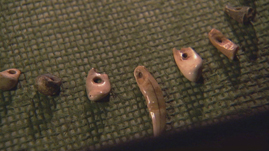Teachers' Domain - Digital Media for the Classroom and Professional Development
User: Preview

Source: The Human Spark: "Becoming Us"




Major funding for The Human Spark is provided by the National Science Foundation, and by the Alfred P. Sloan Foundation. Additional funding is provided by the John Templeton Foundation, the Cheryl and Philip Milstein Family, and The Winston Foundation.
ALAN ALDA (NARRATION) The museum has a collection of hundreds of stone tools, made by both Neanderthals and their modern successors.
RANDALL WHITE While there are a lot of wonderful stone tools here, the really prize possession of the museum is a fabulous collection of some of the earliest body ornaments on Earth. We have here in this museum, there are more than 300 beads and pierced teeth and pierced shells.
ALAN ALDA These are shown as though they were worn like a necklace. But is that how you know they were worn? Can you tell?
RANDALL WHITE No, this is just sort of free interpretation, a way of presenting them in a museum context that has a certain order to it. But we actually find them as isolated beads scattered across a living site.
ALAN ALDA So how were they worn, do you think?
RANDALL WHITE The microscopic analysis and the experimental work that we’ve been doing shows that they were actually sewn onto garments one by one.
ALAN ALDA Like sequins.
RANDALL WHITE Like sequins.
ALAN ALDA (NARRATION) Some of the beads are made from real teeth. But others are copies made in soapstone –and these are fake sea shells sculpted in wooly mammoth ivory.
ALAN ALDA Now, you know, I can imagine some magical reason for copying teeth, the tooth of a powerful animal or an animal you eat. Why would you copy a seashell?
RANDALL WHITE Sort of like Canal Street.
ALAN ALDA Knock offs.
RANDALL WHITE Knock offs. I mean, there’s perhaps some sense that these are valuable things. And if you don’t have them, they come from hundreds of kilometers away, if you don’t have them, you make them.
ALAN ALDA But they already, that means that they’ve got some symbolic significance. I mean, it’s clear symbolism, to make something like something else.
RANDALL WHITE Sure. They’re taking one form out of nature and putting it into something else.
ALAN ALDA (NARRATION) No beads have ever been found at a Neanderthal site, suggesting that in Neanderthal culture symbolism didn’t exist. But beads have been discovered dating back well before they start showing up in Europe. Pierced seashells dating to some 80 or 90 thousand years ago have been found in several archeological sites in Africa and the Middle East. These are among the first solid clues that the humans who stayed behind when the ancestors of the Neanderthals left were on to something new. By 40,000 years ago, beads were being made in Africa from soapstone, requiring several hours of labor.
JOHN SHEA The key thing in human evolution is when people start devoting just ridiculous amounts of time to making these objects. Now imagine we live in two different groups. But we don’t speak the same language, we don’t really know each other. But each of us has one of these beads. That bead tells us that we’re part of the same network. And that’s a very powerful social institution. It extends the network of cooperation beyond the community of people who know each other directly every day to a potentially infinite range of cooperating individuals. And you can see this today in fraternity rings, sorority pins, national flags. These allow us to scale up the number of people who cooperate beyond five or ten people who live with each other every day, to potentially everybody on the planet. It’s a very powerful adaptive strategy, and it’s uniquely human. No other primate, no other mammal, has ever figured out how to do this.
RANDALL WHITE We don’t usually think of body ornaments as being evolutionarily important, but in this case it may be one of the – they are standing for a change in social organization that allowed Neanderthals to be replaced by moderns.
 Loading Standards
Loading Standards